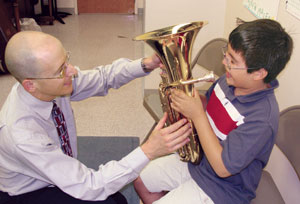
The letter, e-mail, or voice mail usually follows this form: “Thank you for teaching my daughter how to play the clarinet, but she doesn’t want to be in band anymore.” The reasons students quit band or orchestra are numerous, but teachers would rather see students stick with it and be successful.
In the past I’ve recruited new students by having a small group of high school boys and girls demonstrate instruments at beginning-of-the-year assemblies. I have also used the Instrument Timbre Preference Test (Gordon, 1984) as well as many instrument recruiting videos. These are excellent means to generate interest in instrumental music. However, when I had four students quit in one week, I began asking around for suggestions. The owner of the local music store suggested that many students quit before taking enough time to make a reasonable decision about whether the instrument is a good choice. He also suggested that there was no substitute for playing the actual instruments.
I gave each student in the district the opportunity to play flute, clarinet, alto saxophone, trumpet, horn, trombone, and baritone horn. I do not demonstrate percussion instruments because the supply for percussionists is generally greater than the demand. I also do not demonstrate oboe or bassoon because the cost of reeds would be prohibitive, even if the reeds could be sterilized and reused several times.
Students begin playing instruments in fourth grade in my district, and although I do this with third graders at the end of the year, it can just as easily be done at the beginning of the year students start band. I drafted a letter to parents describing the program. I was careful to explain that students were not obligated to join band, but this program was designed to help students decide which instruments might be good choices. I also explained that each instrument would be cleaned and sterilized between playings and invited parents to call or e-mail with any questions.
It is important to have good-quality instruments available, so students will not all flock to shiny alto saxophones, avoiding the beat-up baritone horn. Local music stores will probably be willing to loan instruments during the trial period, as this would likely generate revenue from students renting or purchasing instruments from the store.
If time were not a constraint, students would be given as much time as needed to play each instrument, ask questions, and try instruments a second time. However, this is unrealistic in most cases. I taught small groups of two or three students and let them play as many instruments as they wanted – most chose to play each instrument. I got one student started and let him experiment, then taught a second how to play something different. This approach was extremely loud but efficient.
The best salesmen make people want a product, and directors should follow this approach in helping students make decisions. It is important that students believe they chose their instruments, and they will take more ownership of the program this way. I had to make careful word choices rather than simply telling students why they should not play an instrument.
 When students made decisions, they helped me complete a form with green and red colored pens.
When students made decisions, they helped me complete a form with green and red colored pens.
We circled favorite instruments in green and ones they did not like in red. Instruments about which a student had no strong feelings were left blank. Having students help fill out the form cements the idea that they are the ones making the choice.
In the first year of having students try instruments, only four students out of 91 quit. In addition, 11% more of the class joined band. During the past year I also had to make fewer awkward telephone calls to parents about poor instrument choices, such as flute players still unable to produce a sound late in the year and high brass players with overbites. I still have students who are unsure whether their current instruments are correct, but because they play a central role in deciding what to play they talked to me about it instead of just dropping out.
Over time I have developed a good sense of how to pace these classes, including how much time to spend on each instrument. This has been especially difficult with the flute. It can be very difficult for a beginner to produce a sound on the headjoint, and students can quickly dismiss the flute as a potential choice. The problem is magnified when students can produce a sound rather easily on other instruments. I preface demonstrating the flute with a warning that it can be difficult to get a sound at first, but there comes a point of diminishing returns for students who struggle to produce a sound; this is true for all the instruments.
I have pondered inviting music education majors to help with instrument experimentations. It has proven beneficial to isolate bad habits that might form unless corrected immediately. I can teach every instrument, but as a flutist I know the most about that instrument. A trombonist might spot both great potential and bad habits more quickly than I could. The additional perspective would benefit both me and the students.
Although this program is still in its infancy in my district, the results have been amazing. Having students touch, hold, and play instruments is superior to having students watch, talk, or hear about them, and the work it takes to match students with the best instrument will benefit not only the elementary band, but also the middle and high school programs.






